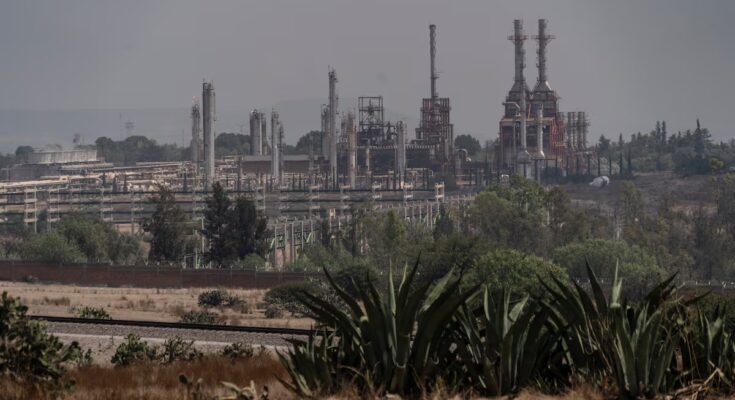Mexico will no longer emit greenhouse gases into the atmosphere by 2050. This is the most ambitious commitment in the 157 pages in which the country details how it plans to meet its new pollution mitigation goals, its third Nationally Determined Contribution (NDC). Presented at the annual meeting of the United Nations Framework Convention on Climate Change, the Conference of the Parties (COP30), in Belém, Brazil, the closest target is to reduce net carbon dioxide emissions by at least 31% to 37% by 2035. All this in a context in which the country’s government promotes the oil industry and boasts the Plan México, an economic development strategy that seeks strategic investments in industry and infrastructure, sectors in which, in fact, emissions increase.
The NDC represents each country’s commitment to meeting the goals set in the 2015 Paris Agreement to reduce greenhouse gas emissions to keep global warming below two degrees Celsius. Currently, Mexico’s greenhouse gas emissions amount to about 583 million tons of carbon dioxide equivalent per year, and the minimum goal, in the absence of international aid, is to lower them to between 364 and 404 million tons by 2035. If we had money and technology from abroad, the reduction would be between 332 and 363 million tons.
“This contribution once again generates hope, since it is a text that addresses the climate crisis in a much more complete way than the previous one,” explains Anaid Velasco, head of Public Policies and Research at the Mexican Center for Environmental Law. “For the first time, a component of means of implementation is included with climate financing measures, training, technological advances… so that everything does not remain of good intentions,” praises Velasco. This component identifies the necessary interventions, also in the context of regulatory reform, to guarantee the conditions that allow the achievement of the objectives.
Another new axis is the loss and damage component which “recognizes the importance of preventing, minimizing and addressing the adverse effects of climate change that persist despite mitigation and adaptation efforts”. “What we here technically call loss and damage, in real life, girls, boys and families losing everything in a few minutes, are the product of a climate exacerbated by a predatory development model,” emphasized Alicia Bárcena, Mexico’s Environment Secretary, during her presentation.
The document also contains a series of goals that Mexico is committed to achieving by 2030, just five years from now. As for greenhouse gases, they need to be reduced by 35% compared to what was forecast for that year, which would correspond to a maximum of 644 million tonnes of carbon dioxide equivalent per year. In 2023, the latest year for which data was published, Mexico emitted a total of 759 million tons.
Within 25 years, Mexico will have to have zero net emissions, meaning the amount of greenhouse gases released into the atmosphere will be equal to the amount eliminated. “It is a very ambitious objective, even more so if we take into consideration the Plan México and the Pemex Industrial Plan, the promotion of natural gas… There is a lot of talk about reduction, but no one says how”, criticizes Velasco.
For Land Use, Land Use Change and Forestry, the country maintains its never-achieved goal of having what is called a zero rate of net deforestation: that the amount of forests and jungles cut down is compensated by an equal area of reforestation or regeneration. The latest public data from the National Forestry Commission indicates that the annual rate of deforestation is 208,000 hectares, concentrated mainly in the southern states. This is equivalent to slightly less than the area of the city of Tokyo, Japan.
For electricity generation, the immediate goal is that by 2030, 38.5% of it will come from clean sources. The latest published data shows that, in 2024, the electricity sector with clean energy will only be 26.5% of the total. To achieve this goal, Mexico is committed to ensuring that more than 70% of new capacity installed between 2025 and 2030 comes from clean energy, but of the 35 electricity generation plants under construction, 18 come from fossil fuels.
Other objectives listed are those set in the Sustainability Plan of Petróleos Mexicanos (Pemex), published in early 2024. In it, Pemex, one of the most polluting companies on the planet, ensures that by 2030 it will significantly reduce greenhouse gas emissions from exploration and production (61%), refineries (40%) and gas processing (60%), as well as lowering its methane emissions by 30% compared to 2020. the document speaks of an investment of 4 billion dollars.
“There’s one thing that caught my attention and that’s that they say they’re going to resolve at least 361 hectares of environmental liabilities,” Velasco says. These are contaminated sites that have not been remediated and continue to cause damage to the environment and human health. “First, it’s a legal obligation, it can’t be a target,” he laments, “and second, that acreage is less than half the size of the Chapultepec Forest.” In its 2021-2025 Business Plan, Pemex has identified a total of 1,376 hectares contaminated by hydrocarbons.
“Mexico is also urgently preparing the National Adaptation Policy, a strategy that converts vulnerability into resilience”, said Bárcena, “the how is as important as the what, so the implementation axis is not decorative, it is a requirement, we need real, accessible and predictable climate financing, not welfare; cooperation and technological transfer, not impositions; co-responsibility, not simulations.” Now we will have to see if, despite Pemex and the promotion of the sector, Mexico will be able (this time) to keep what it promised.



